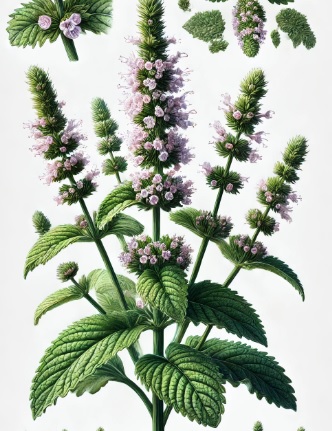Horse Mint, scientifically known as Mentha arvensis L., is a plant belonging to the Labiatae (Lamiaceae) family. It is commonly referred to as "Horse Mint" and is recognized for its distinctive minty fragrance and potential medicinal properties. The plant is used in various applications, including culinary, therapeutic, and cosmetic products.
Chemical Composition and Structure:
Menthol: The primary component, responsible for the characteristic mint aroma and cooling effect.
Menthone: Another key compound contributing to the minty flavor and fragrance.
Other Terpenes and Compounds: Contains various terpenes and bioactive compounds that contribute to the plant's properties and efficacy.
Physical Properties:
Appearance: A herbaceous plant with square stems and ovate to lanceolate leaves. It produces small, pale lavender to white flowers.
Odor: Fresh and minty aroma, characteristic of the Mentha genus.
Solubility: Components are soluble in oils and ethanol, but less soluble in water.
pH: Not typically applicable to the whole plant, but its extracts can affect the pH of formulations.
Production Process:
Cultivation: Horse Mint is cultivated in suitable climates, typically in temperate regions, to ensure optimal growth and high levels of active compounds.
Harvesting: The plant is harvested during its peak growing season to maximize the concentration of essential oils and active components.
Processing: The harvested plant material can be used fresh or dried, and processed to extract essential oils or create powdered forms.
Extraction: Methods such as steam distillation or solvent extraction are used to obtain essential oils or other extracts from the plant.
Formulation: Extracts or oils derived from Horse Mint are incorporated into various products, including cosmetics, personal care items, and therapeutic preparations.
Applications:
Cosmetics and Skincare: Used for its refreshing mint aroma and potential skin benefits in products such as creams, lotions, and masks.
Aromatherapy: Employed for its soothing and invigorating minty fragrance in aromatherapy.
Culinary: Occasionally used as a flavoring agent in food and beverages.
Therapeutic Uses: Traditional uses include relief from digestive issues and respiratory discomfort.
Environmental and Safety Considerations:
Environmental Impact: Sustainable farming practices should be adopted to minimize the environmental impact and ensure responsible resource management.
Safety: Generally safe for use, but individual reactions such as intolerance or allergies should be considered. It is advisable to conduct skin compatibility tests before widespread application in cosmetic products.
INCI:
Fragrance. It plays a very important role in the formulation of cosmetic products as it provides the possibility of enhancing, masking or adding fragrance to the final product, increasing its marketability. It is able to create a perceptible pleasant odour, masking a bad smell. The consumer always expects to find a pleasant or distinctive scent in a cosmetic product.
Refreshing. This ingredient is included in cosmetic products to provide a refreshing or toning sensation to the skin and can also help relieve irritation or redness.
Perfuming. Unlike fragrance, which can also contain slightly less pleasant or characteristic odours, the term perfume indicates only very pleasant fragrances. Used for perfumes and aromatic raw materials.
Synonyms:
CAS:
![]() Horse Mint
Horse Mint 

